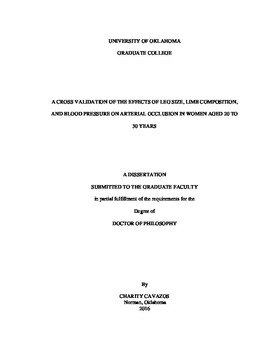| dc.description.abstract | Blood flow restriction (BFR) on the upper and lower limbs, in combination with resistance training, has been found to increase muscle strength and muscle mass. Previous research has used either arbitrary pressures or a pressure based on systolic blood pressure (1.3 x SBP) to try and individualize the restriction of blood flow to the lower limbs. Recent studies suggest that restrictive pressure should be individualized and based on thigh circumference and limb composition. PURPOSE: The purpose of this study was to cross-validate the effects of leg size, limb composition, and blood pressure on arterial occlusion in women aged 20 to 30 years. METHODS: A total of 94 healthy college-aged women visited the laboratory for 2-3 visits. Forty-four participants visited the lab for 2 visits (1 paperwork/screening and 1 testing visit), and 50 women were asked to return for a third visit (1 paperwork/screening and 2 testing visits) to assess reliability and consistency of our measurements. On the first visit, participants completed paperwork and were screened for blood pressure (BP) and ankle brachial index (ABI). During the subsequent visit (s), participants subject’s height, body mass, pregnancy and hydration status were measured. Participants were then tested using Dual Energy X-Ray Absorptiometry (DXA) for determining total and regional body composition, followed by Peripheral Quantitative Computed Tomography (pQCT) of the mid-thigh (50% of thigh length) in both legs to assess muscle and fat cross-sectional areas (mCSA and fCSA). Next, muscle and fat thickness, measured by ultrasound, and thigh circumference at 33% and 50% of thigh length were measured on both legs followed by measurement of ABI and total occlusion pressure. RESULTS: From a total of 94 participants (age = 24.7 ± 2.5, height = 165.6 ± 6.5, weight = 64.7 ± 10.2), 50 returned for reliability testing. Day 1 and day 2 values for height, weight, SBP and diastolic blood pressure (DBP), had strong intraclass correlations (ICC’s; 0.73-0.99), small standard errors of the measurement (SEM; 0.21-3.78) and small to moderate mean differences (MD; 0.6 -10.5). Muscle and fat thickness measured using ultrasound had strong ICC’s (0.77-0.98), small SEM (0.06-0.29) and small MD (0.22-0.82). Regional lean muscle and fat tissue measured using DXA had strong ICC’s (0.95-0.99), moderate SEM (81.89-155.35), and moderate MD (226.99-430.60). Muscle area and fat area measured using pQCT had strong ICC’s (0.99), small SEM (1.51-2.51) and small MD (4.16-6.95). In the regression analysis the variables that remained constant in all three models to predict arterial occlusion pressure included SBP, DBP, and thigh circumference at 50% of thigh length, only the technique (Ultrasound, DXA, and pQCT) used to assess thigh composition (muscle and fat) changed. For ultrasound measurements, STEPWISE method beta weights and partial correlation coefficients explained 62% of the variance (R2=0.620) with the following variables for the right leg, SBP (ß=0.510, P=0.000); thigh circumference at 50% of thigh length (ß=0.266, P=0.000); anterior right 50% fat (ß=0.328, P=0.000). For the left leg, the following variables significantly predicted arterial occlusion pressures were: SBP (ß=0.482, P=0.000); thigh circumference at 50% of thigh length (ß=0.348, P=0.000); DBP (ß=0.225, P=0.006) and explained 64% of the variance (R2=0.638). For DXA, the STEPWISE method explained 56% of the variance (R2=0.560) with the following variables for the right leg, SBP (ß=0.479, P=0.000) and thigh circumference at 50% of thigh length (ß=0.484, P=0.000). For the left leg, the following variables significantly predicted arterial occlusion pressure: SBP (ß=0.482, P=0.000); thigh circumference at 50% of thigh length (ß=0.348, P=0.000); DBP (ß=0.225, P=0.006) and explained 64% of the variance (R2=0.638). For pQCT, the STEPWISE method explained 48% of the variance (R2=0.480) with the following variables significantly predicting arterial occlusion pressure for the right leg: SBP (ß=0.443, P=0.000) and thigh circumference at 50% of thigh length (ß=0.467, P=0.000). For the left leg, the following variables significantly predicted arterial occlusion pressure: SBP (ß=0.356, P=0.001); thigh circumference at 50% of thigh length (ß=0.388, P=0.000); DBP (ß=0.320, P=0.003) and explained 55% of the variance (R2=0.551). CONCLUSION: The results indicate that thigh circumference at 50% of thigh length and SBP are the main determinants of arterial occlusion pressures in both legs for 20-30 year old women. Despite differences in field (Ultrasound) and laboratory (DXA and pQCT) models, the prediction equations explained similar amounts of variance in the dependent variable, occlusion pressure (about 63% for ultrasound averaged across both legs; 60% for DXA averaged across both legs; and 52% for pQCT averaged across both legs). Therefore, arterial occlusion pressure should be based on thigh circumference and systolic and diastolic blood pressures without the need to assess limb composition. | en_US |
